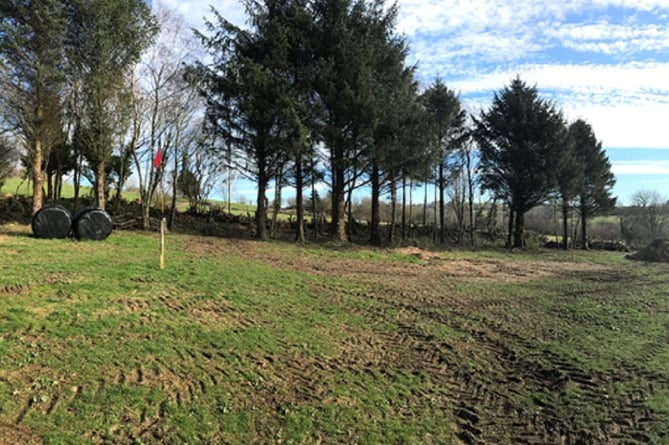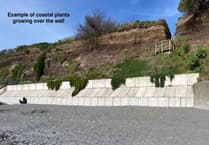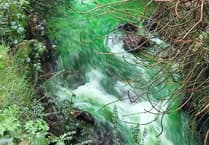A controversial planning application by Eden Project co-founder Sir Tim Smit and his son to build holiday lodges on a golf course in Lostwithiel has been snubbed by Cornwall Council’s ecology department after it said an area of woodland has been removed to make way for an access track.
The council’s ecologist raised concerns that the loss of the habitat at the Gillyflower Golf Course in Lostwithiel – which was removed between 2020 and this year – had not been reported by applicant Alex Smit. The department demanded that a plan for the restoration of the woodland was submitted.
However, Mr Smit’s own ecology expert says the woodland was coppiced and not cleared, and that a population of dormice – a protected species – has not been affected despite the council’s concerns to the contrary. He said the work has nothing to do with creating an access track.
Tensions have been running high in the town over the controversial planning application by Sir Tim Smit and his son Alex to develop the Gillyflower site they own above the town.
Sir Tim’s initial development proposals were denied by council planners in April 2022. The plans originally included holiday lodges, a café and education centre on the golf course. The rejection came after a huge backlash from the local community, which submitted 300 objections and organised demonstrations.
New plans were submitted earlier this year under Sir Tim’s son Alex’s name, which still include 19 holiday lodges as well as a clubhouse and reception. More than 500 comments were made on Cornwall Council’s planning portal both for and against the proposals.
The development has become such a contentious issue in Lostwithiel that it’s been described as ‘toxic’ by people on both sides of the argument. Colin Martin, the Liberal Democrat Cornwall councillor for the town, even took to Facebook in June to warn about some people’s behaviour following allegations of threats outside a public meeting in Lostwithiel to discuss the plans.
In July, the council made the rare move of turning off comments about the application on its planning portal due to the “number of concerns raised about misuse of the system”.
Now the council’s own ecology unit has said it cannot support the application due to the removal of the woodland and the effect it may have had on a dormouse population within the habitat. A report states: “Consultation with Natural England will be required if a dormouse licence was not obtained for these works to agree on an appropriate level of compensation.”
An ecology officer added: “Besides woodland, further areas of suitable habitat (scrub) also appear to have been reduced. Furthermore, we have been made aware of further hedgerow removal in the wider site to provide new access. As dormice use hedgerow habitat, this hedgerow removal may have also breached legislation regarding dormice and should be considered within the cumulative impacts of the development.
“This has resulted in the fragmentation of the woodland parcel from nearby suitable habitat and direct loss of priority habitat known to support a European Protected Species (dormouse). No information was provided in the ecology report relating to this woodland removal or whether a mitigation license was granted for these works. No retrospective compensatory measures have been proposed or provided.”
The officer added that photographic evidence from a council site visit in February shows that areas of the woodland were cleared. The applicant’s own ecological expert Paul A Diamond, of Ecological Surveys Ltd, was asked why it was carried out “as the area looks significantly larger than would be anticipated for widening of a track for vehicular access”.
Mr Diamond replied last week: “You are correct with regards to the amount of brash [parts of trees not removed from a site after felling] being significantly more than would be expected for the widening of a vehicular access. The reason for this is that the access was widened in 2019 and the brash has no relationship to the access opening. The brash above relates to coppicing of the understorey within the ‘woodland’.
“Coppicing is of course a valuable component of woodland management and cannot be considered ‘clearance’ which obviously has a negative connotation.”He provided photographs taken this year which “clearly illustrate the regeneration taking place”.
Mr Diamond added that all of the species there previously, including dormice, are still there. “There are no losses as such and the woodland is to all intents and purposes as it was previously. I do not and I doubt many would, consider the work undertaken to be negative in any way. In fact, I consider it laudable that the client has undertaken this work.”
Cornwall Council also requested a 10m buffer zone was created adjacent to the woodland due to the presence of the protected species.
Mr Diamond responded: “I completely understand the concept of 10m buffers, and ordinarily on normal development sites, would be advising the client that this should be observed. However, the locations selected for the lodges have to conform to landscape requirements too.
“The designs of the lodges ensure no damage to tree RPAs [root protection areas] and their locations also add to the attractiveness and appeal of the lodges. The lodges are an essential part of the Gillyflower experience and their proximity to the woodland gives them a special quality.”
An overall decision on the application is pending.




